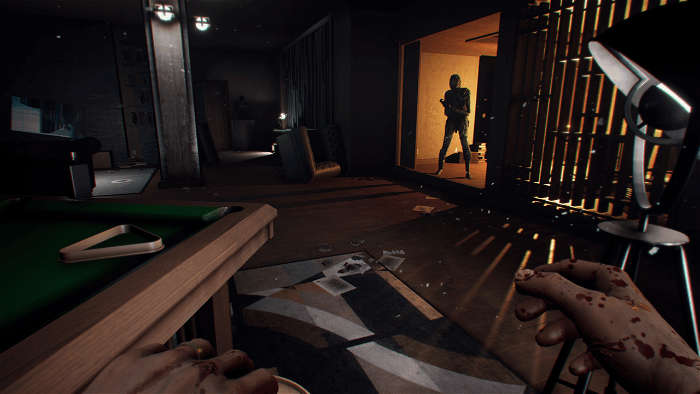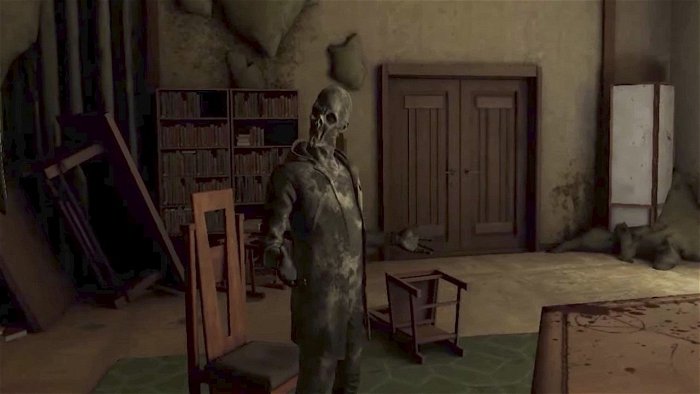The World of Darkness is just one of the universes which scream “if you can’t beat them, join them.” The long-serving franchise is taken directly out of classic folklore, across tabletop RPGs created by Mark Rein-Hagen since 1991. But in a twist, players aren’t just diving into a familiar world of ghost, vampires and werewolves. The World of Darkness instead makes you the monster. This added a new layer behind the perspective of survival. Instead of staying alive, it’s the concept of death which takes away much of what makes players vulnerable. In its place comes first-world problems with being a monster. From avoiding garlic and bloodlust, to protecting werewolves through environmentalism and solving your own murder; much of the World of Darkness is a test for players who’ve always wondered if it’s easier to become the hunter.
Wraith: The Oblivion – Afterlife is the latest to literally put players in the titular realm of the dead. Inspired directly by the 1994 board game, the first person RPG narrative became a fit for a full length VR horror game. It’s also the fourth title from Fast Travel Games, who have found their own formula in first person experiences. Games like Budget Cuts 2: Mission Insolvency and Apex Construct and The Curious Tale of The Stolen Pets have also given the studio enough time to study the VR platform. This became a learning factor for Fast Travel, tasked with turning the tables and making players the titular Wraith in a desolate mansion. Though players have already paid the piper at the start of Wraith: The Oblivion – Afterlife, becoming a classic spirit is only the start of their quest to uncover their deaths as a photojournalist while being hunted by far worse entities at every corner.
CGMagazine sat remotely with Wraith: The Oblivion – Afterlife game director Erik Odeldhal from Swedish-based studio Fast Travel Games, discussing how his lifelong love for RPGs and vintage horror classic films tied into creating a horror game he’s always envisioned in VR.
CGMagazine: Following your last VR game (The Curious Tale of the Stolen Pets), how did the idea of creating a game like Wraith: the Oblivion – Afterlife finally come to?
Erik Odeldhal: So our previous games have been in completely different genres. Apex Construct is an action adventure, Budget Cuts 2: Mission Insolvency that we did with Neat Corp is like a stealth game, I guess, more and more a stealth adventure game. Curious Tale of the Stolen Pets is a very family friendly puzzle game. But all these three games have one thing in common: and it’s the focus on player presence and the player’s actions in the world and giving the player a believable fantasy. And in that sense, Wraith: the Oblivion – Afterlife is very much like a continuation of what we’ve done. The fact that we’re building a Wraith: the Oblivion horror game, is actually because 70% of the game devs in Stockholm have their offices on the same island. So and we all know each other really well. We have great friends at Paradox who own the World of Darkness IP and Wraith VR is a part of this “world of darkness”. The other brands or IPS within the World of Darkness as Vampire: the Masquerade, Werewolf: the Apocalypse for instance. But basically they came to us and they asked us if we would be interested in pitching something for Wraith the Oblivion. They thought Paradox wanted to dip their toes in VR and they basically asked us “Can you pitch us something?” Wraith: the Oblivion, as tabletop RPG as its foundation. And I personally love that. I’m a role player since I was nine years old. And so we created a pitch and they’ve really liked it. And that’s kind of how it went. But the game is an original story, etc. It’s built on the themes and parts of the rules from the pen and paper RPG, with our original take on the World of Darkness.

CGMagazine: So how did the RPG kind of perspective from Wraith factor well into something personal and immersive like VR?
Erik Odeldhal: It’s role playing games and it’s settings that are based on where you basically ARE the monster. But there’s tales of personal horror. This is the overarching theme for all World of Darkness stuff. To us, this worked really well. I’m a role player, I’m a huge horror fan. I love horror. I love the VR games. So for me personally, this was very much a chance to do horror, the way I think it should be done in virtual reality. And with how the team thinks it should be done, which is basically to focus less on on jump scares and really focus on player immersion and player presence. And using the strengths of VR, where you are basically in the world. That’s a big thing for me with VR, and use that to craft the horror experience that is a bit slower, builds tension over time, and doesn’t rely too much on just shock and jumpscares. But also tries to tell a good story, I hope, but it also builds tension all the time. I think that was the main launching point. And with the Wraith the Oblivion books, we chose to not focus too much on the actual RPG mechanics and rule set, but rather the themes of the book.
And Wraith is about characters who, just like the protagonist in an afterlife, you’re dead. But you have a very strong tie to the world of the living. So you basically don’t really let go. And when you die, you kind of get split in two. There’s the conscious part, that’s you the player, but then there’s the dark subconscious, the Shadow, which is a companion that is always with you. We chose to interpret that quite literally (laughs). He literally is with you the whole time in the game, because you hear the voice in your head, sometimes you need him and he walks around in the house with you. But he’s your guide, but he’s also someone who wants you to fail. But he’s dead too. So I think we we focused a lot on the themes (death, afterlife) of the role playing game rather than the ruleset.

CGMagazine: And of course, most horror games and stories have players alive across the experience. How big of a decision was it to kill players right off at the start?
Erik Odeldhal: It’s kind of a prerequisite for creating something in the Wraith: the Oblivion world. The thing is, there’s a mystery around your death, which figures very much into the story that we’re trying to tell. And also the fact that you are a Wraith, that you are dead, it also gives you some supernatural abilities that we felt was really, really interesting to explore in VR. You have stuff like Insubstantiality, which lets you move through solid walls, which is the interesting thing you have. Wraith Grasp which is a telekinesis-like ability that lets you lift items, heavier items and move them around and stuff like that. And these were things that we felt would work really well in VR. Yes, you are dead. But there’s always stuff in anywhere it seems that are much worse than you. So in Wraith: the Oblivion, first of all, you have the Shadow with you, but also Spectres who are categorized as Wraiths who have really lost all their contact with their humanity and they’re agents of Oblivion. They’re just pure malevolence, and horror. And we have a couple of those stalking you through the hallways in the Barclay Mansion, where the game takes place.
CGMagazine: In having that kind of presence, I do understand that the Wraith is single player driven, there’s not a lot of different like multiplayer elements as the RPG. So how do those Spectres and other characters around that game, fill that void of just not having real people?
Erik Odeldhal: Afterlife is a game where you as a player don’t really have any offensive means. You don’t have any weapons and you can’t hurt your enemies in any way. So it’s very much a stealth title where you have to stay out of sight of the enemies. They can do a lot of damage to you (laughs). So you have a couple of ways to defend yourself that you find and unlock during the course of the game. But the game is very much based on players exploring the Barclay Mansion. It all takes place in this one giant building, garden and parts around it. And so it’s about exploring this and getting access to more and more of this mansion as you play through the game, and trying to figure out the puzzle of how and why you died and why you can’t leave. And then the story develops from from that.

CGMagazine: With you being like a lifelong horror fan and watching horror movies since you were growing up: when you were making the characters and that kind of universe in the game, were there any kind of figures that reminded you of some of the movies that you watched?
Erik Odeldhal: Actually, the game takes place outside of Hollywood. And it’s, it’s actually set against like a backdrop of movie production. So several of the characters are actors and movie producers, so that was one of the cool things. I wanted to create a story around that. It’s influenced quite a lot, I say. The game is influenced quite a lot by some of the horror movies that I really loved, and that I’ve watched multiple times over the years. And several of them are actually a bit old, like The Haunting from the 60s, or The Changeling from the 70s. And the movies that, just like our game, really focus on building tension, and then raising that tension to almost levels that are really, really scary that the player might notice as a viewer.
CGMagazine: So in terms of actually striking that tension at the heart of VR players, what are some of the ways that the atmosphere or the environment itself does that?
Erik Odeldhal: We work a lot with lighting, of course, and basically you can’t see super far. We want to basically obscure what’s ahead of you at times, in different places. We use audio a lot to create an environment around the player. Audio plays a big part in building tension. Not necessarily just music, even though that is also one of the tools. But creeks of wooden floorboards, or the wind in some places, etc. and the voices of the Spectres and the other characters the remnants. See, there’s a cast of characters that you’ll basically get to re-experience parts of what happened with in the days before your death. So you get to hopefully get to know these characters that were in the building with you before he (players) died.

CGMagazine: Of course, players will be chased by all sorts of different enemies in the game and much like a lot of different games, like Resident Evil 2 with Mr. X and a lot of other games like Murdered: Soul Suspect where they had different Spectres. Why was it such a big decision for you guys to add a looming presence in Wraith?
Erik Odeldhal: We don’t want the player to feel that any area necessarily is safe. We wanted to remove this feeling of you playing through levels (linear). I love the Resident Evil 2 Remake. I think the Mr. X character was a wonderful thing and really kept me on my toes. Also I love games like Alien Isolation when the Alien can pop up anywhere. But in these games there are, which I think is important for all horror games, there are “valleys” I guess, in the tension, where you actually have time to explore, look around and maybe focus a bit more on some of the story elements before we rack out the tension, again, letting you know that the Spectre is on your heels again.

CGMagazine: Do you think there’s an art to just building an entire game based off one location like the mansion, as compared to having different set pieces? Or, of course, locations, as you’d say?
Erik Odeldahl: I definitely do. And I love both ways of building games. For this game, we felt that having everything take place in one. It’s a big place, though. But we felt that we could create something that we feel is believable, has a specific type of architecture and architectural details. And it’s basically a house that I believe could exist in real life. Obviously, we’ve done things where it can only work in games. But still, to me it was really important that we build a believable place and let the player character explore that. So we didn’t want the location to feel like you’re in a game necessarily. There are great games that do that. And then see how can we create interesting puzzles and exploration challenges and enemy encounters that revolve around stealth in that place. I think we succeeded really well. And I hope the players do succeed.
CGMagazine: And more on that believability; were there any particular techniques or elements that you felt like you wanted in that kind of real scale for virtual reality?
Erik Odeldahl: So first of all, it’s really important important for us to have to let the player interact with things in the proximity in a believable way. Lift things, throw things, they should have a weight that feels real. So I think that has always been a focus for us in all our games. And you play as a character called Ed Miller, who’s a photographer and you have his hands and his arms that you see in the game. Putting the player in in Miller’s shoes was a big focus for us. Another big focus was that once you leave the menu screen, there are no loading screens or anything like that. The whole mansion is seamless. So you can you can explore it without any loading. It loads a lot, but you won’t see it. You won’t feel it. And that I think really tied the house together. Yeah, basically, after quite far into the game, you basically have access to all of the house, you have all the areas un locked, and you can move between them without any experience whatsoever. And I think that was a great choice to focus on that (believability).

CGMagazine: And before I let you go, I want to go back more into the universe side of Wraith. How are players, or at least players who’ve done the tabletop games and are familiar with these universes know that they’re in that kind of World of Darkness? Are there ways in the game that’ll show people they’re in the same world as Vampire: the Masquerade or Werewolf: the Apocalypse?
Erik Odeldahl: There might be a couple of Easter eggs (laughs). We did we did focus on establishing the Wraith the Oblivion universe. I mean, that was our main focus. This is the first time Wraith has been adapted to a video game or VR game. Definitely so. So we take this as an opportunity to introduce players to the world and introduce certain concepts such as the Shadow, or the Shadow Lands, which is layer closest to the world of the living. And that’s where most of our game takes place. There’s a whole underworld, a super exciting underworld, in the role playing books. But we didn’t really want to throw everything at the player. But rather, you know, give them a good introduction, hopefully, you know, wake an interest in the world of Wraith the Oblivion. And the other parts, as well.
CGMagazine: As you said, there are a lot of things are coming at players, but were there any concepts that were just too downright scary to have in the game for players in VR?
Erik Odeldahl: We had a couple of mantras when we started developing the game. One of them was actually “you can’t half-ass horror.”
You have to really believe that you built something really scary. And we have done so we believe. But we have also made sure to give the players those “valleys” you know, where they can actually relax a bit and, you know, breathe out, etc. I think that in VR, it’s very, very easy to scare people with super loud noises or jump scares, or stuff like that. And while that does work in some experiences, we chose to stay away from that because it can also be a bit fatiguing. If it happens too much. It’s a problem. And we basically said let’s let’s not do too much of that. We still have a couple, hopefully, where you least expect them. But I think just balancing the horror aspect with the exploration and the calm before and after the storm, I think that has been our way to handle the horror. We do want a lot of players to enjoy our game. But we also said that you can’t really, if you want to build a “scary” game, you have to build a scary game. We can’t make something that isn’t scary. To me, that’s not the point of horror.

CGMagazine: Eric, thank you so much for taking the time to of course cover a lot of what we talked about. And if you don’t mind me asking, how is the team doing close to launch? And what were some of the challenges like making Wraith over the pandemic?
Erik Odeldahl: The team is is doing really well. I think a lot of us are actually relaxing quite a bit and just know, being happy about the upcoming launch and really looking forward to celebrating it over Google Meets. Because we all of course work from home. So 75% of the game is built during the pandemic while we were working in quarantine in our homes and I think everyone is really looking forward to seeing each other again when it’s safe. But people are doing really well. And looking forward to the launch. And looking forward, with any game developers, also looking forward to the next thing. There’s always a next thing for us as well, to take the basically what all the learnings and all the good things of this development, to see what we can do to improve on that as well. The next thing, of course.
Wraith: The Oblivion – Afterlife is the fourth VR title from Fast Travel Games and launches today on the Oculus Rift, Oculus Quest/Quest 2, HTC Vive, SteamVR supported platforms and PlayStation VR headsets.




